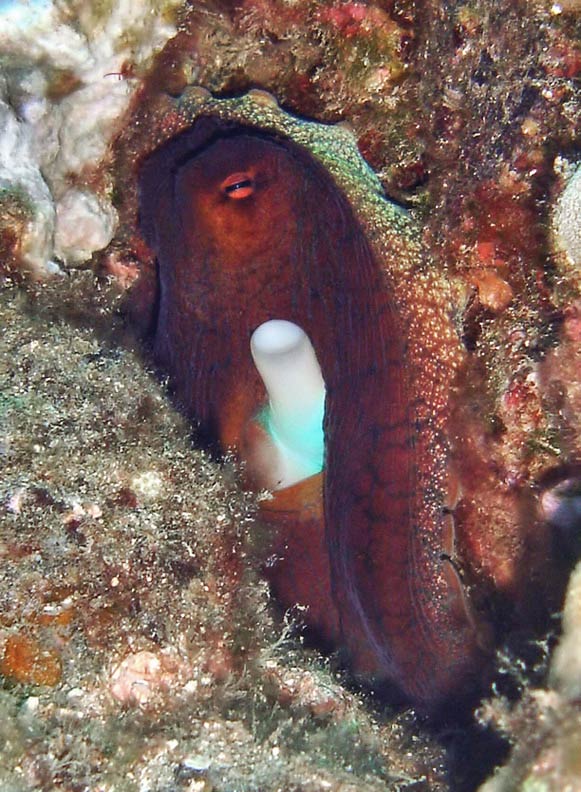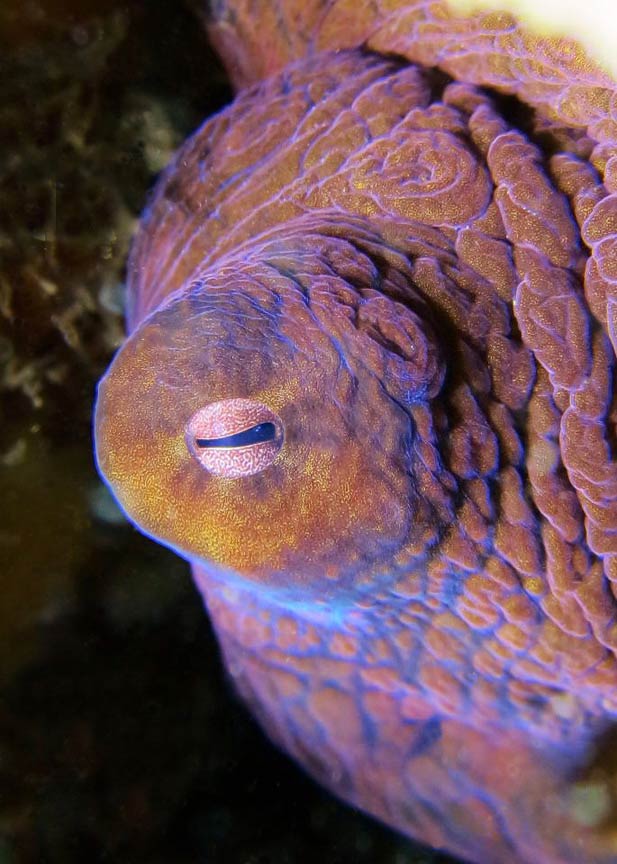The day octopus (Octopus cyanea) is so common in Hawaii that anyone who dives here regularly has seen heaps of them over the course of their diving career. They range from mottled brown to maroon to sometimes even white. But the other day I saw one that was practically glowing with a bright cyan color on its funnel. And it struck me – maybe THAT’S why the author named it cyanea! Why didn’t I ever know that?

Octopus cyanea with cyan sheen. Photo by P. Fiene
I guess I’d seen a cyan sheen on the body and arms of them in some of my and others’ photos, but it wasn’t until I saw this bright patch on the funnel that it made me stop and think.
I went online and started searching for the etymology of the name. Cory Pittman located the original 1849 description online, but back then descriptions were much less detailed. Here’s the entire description of this species, which could fit on a single index card:
Catalogue of the Mollusca in the collection of the British Museum.
By British Museum. Dept. of Zoology, John Edward Gray
Octopus cyanea
Body (in spirits) ovate, above rather granular, beneath smooth. Ocular tubercle rugose, superior. Arms rather elongate, conical; order of length, 2, 4, 3, 1. Cups large; the tenth to the twentieth of the second and third pairs of arms larger, equal-sized; the lowest, especially of the ventral arms, one-rowed. Web broad, minutely granular above, especially between the upper arms.
Hab. Australian seas.
a. Coast of New Holland. In spirits. Presented by J.B. Jukes, Esq.
b. ? _______ ? In spirits?
And, there was no section for the etymology (origin of the name) that is standard in scientific descriptions today.
So, I Googled some more. Further reading showed that Cyane was also the name of a mythical Greek nymph. Could this be the inspiration behind the name? To confuse things further, the name Cyane means dark blue. So was the octopus named for the Greek nymph only? Or was it named for the the nymph, Cyane, because Cyane means dark blue?
Oh, sure, I could have just looked in John Hoover’s Hawaii’s Sea Creatures where he blurts out the answer, but I’d completely forgotten to check the most obvious source!

Octopus cyanea showing cyan sheen. Photo by Jeremy Bricco
I continued my online search. In the Catalogue of the Mollusca, where the original description of cyanea was published, the author described nine more species of octopus and he named seven of them after other mythical Greek figures (aegina, eudora, cassiopeia, cephea, geryonea, polyzenia) or female Greek royality (berenice), with no apparent connection to any morphological features of the particular octopus to which they were attached. Other researchers were handing out names from Greek mythology as well, so maybe cyanea was just assigned a mythological name at random.
In addition, Gray described Octopus cyanea from specimens preserved “in spirits,” not from living animals. In looking at many photos of living Octopus cyanea, such as this one taken by Jeremy Bricco, it appears that the cyan sheen is only apparent when light strikes the skin at a particular angle, suggesting that it’s the product of refraction of light from structures in the octopus’ skin or mucus, rather than reflection of light from pigments in the skin. All this to say that the cyan would likely not have been visible to Gray when he looked at the pale body of the preserved animal.
How perfect is that! The author named this species after a mythological nymph, Cyane, whose name means dark blue, likely without knowing that the animal actually exhibited this color in life!

Comments 3
What are the odds?
I really enjoyed reading that, learning that, and seeing the pictures. I LOVE people who are curious. We get to be AMAZED!
THANKS!
Great article! Thanks for sharing.